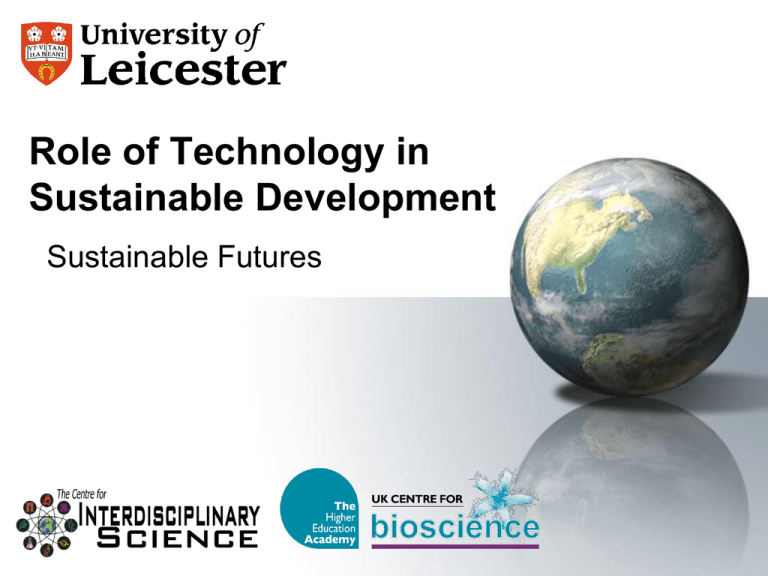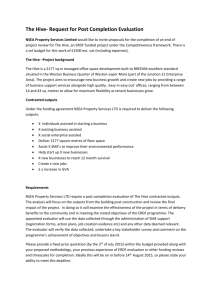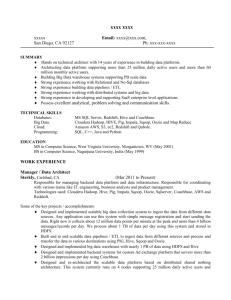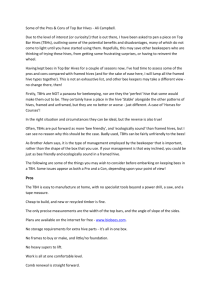Role of Technology in Sustainable Development
advertisement

Role of Technology in Sustainable Development Sustainable Futures Unit 1 - Topics Covered • • • • • Technology and Economic Growth Impact of Technology (positive and negative) Barriers to Uptake of Technology ‘Appropriate’ Technology Diffusion of Innovations Emerging Technologies Different Viewpoints “Technology will get us out of this mess” “Technology got us into this mess” “It is our approach technology that is important” Discussion Points • What are the positive and negative aspects of technological development? • Has technology had a net positive or negative effect? E-waste • An estimated 40 million tonnes of electrical waste is produced each year • Much of the waste contains harmful chemicals which are damaging to the environment and human health Discussion Points • Why did technology develop differently on different continents? • What the barriers preventing new technologies from reaching developing countries? • Are people in developing countries less receptive to innovation? Appropriate Technology Typically, appropriate technology: • Is labour intensive and made from locally available materials • Utilises sustainable sources of energy • Does not require access to centralised infrastructure or materials or skills imported from elsewhere. Hand-operated water pump Appropriate Technology Examples: Objects • How useful would they be in rural Kenya? • Do they fit the definition of ‘appropriate technology’? Briquettes Mobile Phones • An estimated 17.5 million people out of Kenya's 38.5 million population own a mobile handset (up from 200,000 in 2000). • They have applications including health, agriculture and mobile banking. Diffusion of innovations The innovation • Characteristics of an innovation determine its rate of adoption: 1. 2. 3. 4. 5. Relative advantage Compatibility Complexity Trialability Observability Diffusion of Innovations Re-invention: • An innovation is not necessarily invariant during diffusion. • Re-invention is the degree to which an innovation is modified during the process of adoption and implementation. • Innovations diffuse more rapidly when they can be modified easily. Lake Bogoria Beehive Example • Three types of hive are used in the area: – Traditional Log Hives – Langstroth Hive – Kenyan Top Bar Hive (KTBH) Log Hive • This is a traditional hive that has been used in African countries for hundreds of years. • Made from the trunk of a felled tree the hive is simple to construct. The hive when harvested causes the destruction of the comb if this is not used to make beeswax products then it is a waste as the bees have to rebuild the comb before producing more honey. Langstroth • Widespread use in Europe and America • It includes a queen excluder • The frames guide the bees to build comb, and also strengthen the combs allowing the hive to be transported to a different location. Kenyan Top Bar Hive (KTBH) • First developed by Professor G.F. Townsend in Canada, for use in East Africa. • The presence of the top bars allows for the beekeeper to manage and inspect the hive much easier than log hives • However without a full frame like the Langstroth hive the comb is weak and can break off, making it very difficult to transport hives. • The local community has shown initiative by the development of a queen excluder in traditional log hives. Diffusion of innovations Time • Innovativeness and innovator categories Articles • What innovation(s) appear in the article? • What factors have allowed the innovation to be adopted? What factors have hindered the adoption? • What benefits has the innovation had? What are the possible negative impacts? • Assess the characteristics of the innovation that will affect its rate of adoption: relative advantage, compatibility, complexity, trialability and observability. Technology and Energy • Developments in power generation technology often lead to advances in other technologies • Move towards low-carbon technology • How does uptake of renewable energy compare in developed and developing countries? Pay-as-you-go solar power http://www.azuri-technologies.com/ Role of the Internet • The internet has decreased the importance of physical difference between peoples. • It has increased the rate of diffusion of innovations Role of ICT • Developments in ICT such as writing, the printing press, the internet and mobile phones have lessoned barriers to communication and allowed interaction at a global scale. • Lack of access to electricity and other infrastructure has blocked the uptake of ICT in some developing countries. Discussion Points Emerging Technologies: • E.g. solar photovoltaic cells, hydrogen powered cars. • Why has uptake of these technologies been limited (so far)? Lazy User Model • If presented with a selection of options which all fulfil the needs of the user, the user will select the easiest option. • Further reading: ‘New-year irresolution’, The Economist (on blackboard) – Discusses ways to incentivise people to adopt new innovations. Conclusions • Technology is needed which breaks the link between economic growth and environmental damage/resource depletion. • Technology is not a quick-fix solution but it can be part of the answer. • Understanding ‘diffusion’ can help us understand the factors affecting rate at which new technologies are adopted. • Concept of ‘appropriate technology’ is important for sustainable development, but there are some exceptions. Assessment Information for policy makers • There are 2 main policy issues covered in this unit: – Domestic issues: uptake of green technology in the UK – Investment in developing countries: what are the best technologies to promote sustainable development and how can they be encouraged?











